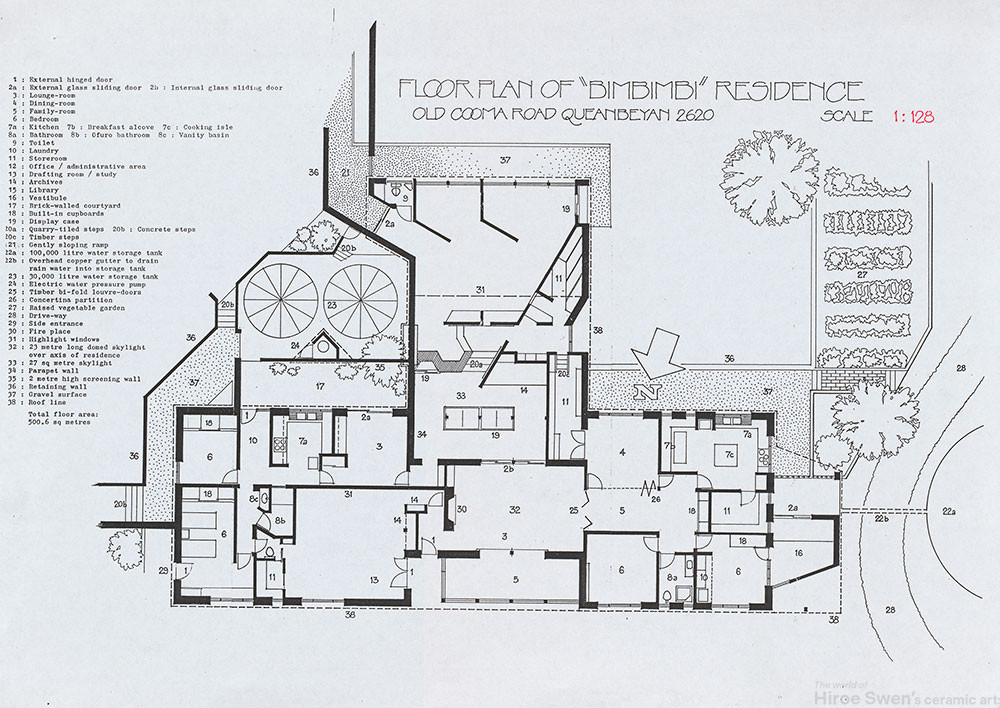
Floorplan of new Bimbimbi residence prepared by Cornel Swen, c1987.
Pastoral Gallery was located between two residential wings.
Pastoral Gallery 1973-2003 : History
Meredith Hinchliffe
Cornel and Hiroe Swen built and ran the Pastoral Gallery on the outskirts of Queanbeyan, NSW. It was one of the earliest galleries run by artists. The gallery was highly respected and successful for thirty years.
The idea for the creation of the Pastoral Gallery had its genesis in Kyoto, Japan, when Cornel Swen, a graphic designer/artist, was introduced to Hiroe Takebe in 1965.
Upon learning that Hiroe was a ceramist, running a small restaurant in the evenings, he was highly impressed by her determination to become a full-time professional artist. When he saw her hand-built ceramics, he immediately recognised their outstanding artistry and unique reference to modern abstract painters from Europe.
After their marriage in 1966 and a further two years together in Kyoto, the couple dreamt of running their gallery in Australia strictly on their own terms, so becoming completely independent, self-motivated artists.
They had very determined ideas about how to run a successful gallery. These included ‘educating’ their audiences, so potential buyers knew why a particular piece was worthy of its price and why one work was ‘better’ than another. Cornel and Hiroe always felt that most gallery owners and staff were lazy: not engaging with those who visited, and not promoting the exhibited artworks.
They originally planned to live and work in Cornel’s Darlinghurst Studio/home in Sydney upon returning to Australia in 1968. Still, it was impossible to build a pottery studio on the premises and this led them to search for a small rural property, somewhere south of Sydney.
Hiroe was offered a part-time teaching position in Canberra, and Cornel was successful in his application for the position of an A-grade journalist in the Department of Immigration, also in Canberra. They purchased a twenty-two-hectare sheep farm named ‘Bimbimbi’1 on the outskirts of Canberra.
The success of Hiroe’s exhibitions in Melbourne, Sydney and at the Embassy of Japan in Canberra encouraged the couple to double their efforts to open their own gallery as soon as possible.
They could now begin building their dream gallery. A half-completed residence on the ‘farm’ was a highly original structure with spectacularly exposed rafters supporting a full-length fibreglass rooftop dome that bathed the interior of the home in bright, natural light. The natural light enhanced the gallery’s display areas, casting evenly diffused light over the exhibits. Cornel began to adapt the interior to create special exhibition spaces and converted verandahs into intimate display areas. Spectacular views across Googong Valley enhanced the gallery’s serenity and spaciousness.
The opening exhibition of the Pastoral Gallery was in November 1973. Well before the advertised opening time, visitors had started gathering in front of the gallery. In a gesture of goodwill – and typical of the way the gallery operated – they allowed visitors to enter well before the official opening time.
They paid particular attention to the way the works were exhibited. The works spoke to each other, through surface decoration or form.
A recurring motif was the frequent use of the hexagon in the floor plan, three recessed showcases and display pedestals. The showcases fitted together without any gaps, efficiently using space and building materials. It is a pleasing shape and became a symbol, almost a logo, of Cornel’s designs of stationery and Christmas cards and other printed items for the gallery.
Initially, they only displayed Hiroe’s ceramics. Several times they invited other ceramicists to exhibit, but buyers only wanted Hiroe’s work. Once he had time to make batik paintings, Cornel also showed his own work.
After a few years, Cornel built a south-facing studio for his batik paintings and an attached flat for Hiroe’s parents. Both additions overlooked an inner courtyard. Sadly, this part of the complex was destroyed in an electrical fire in 1986. But it didn’t stop them running their own gallery. They rebuilt it on a bigger scale, improved its design and reopened in 1988.
In 1994, Cornel stopped dye-painting due to mounting health problems caused by the medium’s toxicity.
Cornel undertook most of the financial, administrative, and physical work associated with Hiroe’s exhibitions, which were held almost annually for many years. This allowed Hiroe to focus entirely on the creative side of making works of art for sale.
The Pastoral Gallery was unusual in the Australian gallery scene at the time. It was operated solely by the artists, giving them total control over the display, prices, timing, and audience. The gallery was successful, both financially and artistically.
After operating the Pastoral Gallery for over three decades and living on a vast acreage that required annual bushfire hazard and weed reduction, they decided to downsize. Sadly for its loyal patrons, it closed in 2003.
However, this did not mean the end of exhibiting for Hiroe. In 2000 Craft ACT held a retrospective exhibition – Hiroe Swen’s Ceramics from 1965–2000 – as the inaugural exhibition in its then new premises in North Building. Since then, Hiroe has exhibited in Western Australia; the Drill Hall Gallery at the Australian National University in Canberra; Narek Galleries, Tanja, NSW, the Watson Arts Centre, Canberra, and most recently at the Sturt Gallery, Mittagong in 2020.
July 2022
Notes
1 Bimbimbi is the indigenous word for ‘place of many birds.’




Meredith Hinchliffe
Meredith Hinchliffe AM is an arts advocate, writer, critic and donor to national and local cultural organisations. Meredith was the first full-time employee of Craft ACT in the mid-1970s. She later joined the Canberra National Sculpture Forum committee and chaired Ausdance ACT for many years. Meredith has written and published numerous articles on Hiroe’s ceramics over the decades.
In this project, Meredith contributed an essay and an artist bio.